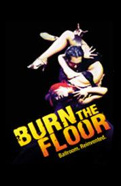Jason Gilkison: Burn the Floor and the Ballroom Renaissance
About the author:
For the past decade, Burn the Floor has been an international hit, thrilling dance fans with 25 high-energy ballroom routines in which as many as 10 couples share the stage. And not just any couples: These dancers are international champions who join the show after retiring from competition. Director/choreographer Jason Gilkison knows exactly how to challenge these thoroughbred dancers because he’s a former world champion himself. After hanging up his dancing shoes, the Australian Gilkison got his feet wet on Broadway staging five numbers for Dame Edna: Back with a Vengeance and has choreographed the closing ceremony at the Sydney Olympics as well as routines for TV’s So You Think You Can Dance. Understandably thrilled at the opportunity to bring Burn the Floor to Broadway’s Longacre Theatre, Gilkison traced his history, and that of the show, for Broadway.com.![]()
I was born into ballroom. My grandfather opened a dance studio in Perth in 1931 after moving to Australia from Scotland. His five children, one of whom was my mother, eventually took over, so it’s in the blood. As a child, I would go the studio on Saturdays and get into mischief with a girl named Peta Roby while our parents taught lessons. Peta and I used to get up and imitate the dancers, so by the time we were seven, my mother said, “We might as well let them dance together.” For the next 35 years, Peta and I competed around the world, eventually becoming first Australians to win the world championship in Latin dance. I have nothing but wonderful memories of growing up in a dancing family, and Peta continues to work with me as the associate producer of Burn the Floor.
Our company got its start after a group of eight couples put together a 15-minute ballroom show for Elton John’s 50th birthday. He was a having a huge masquerade ball and wanted some tongue-in-cheek entertainment. Well, our little floor show got a huge reaction from the A-listers who were there, including producer Harley Medcalf, who asked, “Why hasn’t anybody thought of doing ballroom in a theatrical setting?” Harley took up the challenge himself, and in the 10 years since then, Burn the Floor has been presented with great success in more than 30 countries.
In the beginning, our show toured huge arenas, then we began scaling it down and making it more and more theatrical. The version we’ve brought to Broadway is the most dynamic we’ve done. The dancers are able to feel organically connected to the dances they’re doing, which makes the show a lot more sensual and feisty and raw. It’s like taking a piece of your grandmother’s jewelry and putting it in a modern setting: We wanted to keep the essence and the beauty of dances like the quickstep and the waltz and the excitement of the jive, but show it with the energy and attitude of the dancers in this generation.
Audiences tell me that they’re amazed at the speed and intricacy of the dances in Burn the Floor. In fact, competitive ballroom dancing is recognized in Europe as a sport, and world-ranked dancers compete like athletes. One of my challenges as a director is to get the dancers to let go of their competitive spirit! When they’re onstage in this show, it’s not about proving themselves, it’s about creating a character and expressing themselves in dance.
It takes a special kind of dancer to excel in ballroom. If someone comes in with a selfish attitude, they won’t last long in this genre. Synchronization—the essence of two people moving as one—is key. As a dancer, you have to make the journey feel as wonderful for your partner as it does for yourself. It’s a completely different way of moving the body, like one soul with four legs and four arms.
After a decade touring the world, it’s very exciting to bring Burn the Floor to a Broadway stage. When Joe Watson, one of our producers, first suggested the idea, I was taken aback, but he pointed out that there hasn’t been a pure dance show on Broadway in a long time. And that’s what we are: pure dance, with lots of choreography that shows where ballroom has come from and where it is right now. We’re not a musical, we’re a dance-ical, and I feel so lucky to work with a company of dancers who are passionate about showing off their art form.
Looking back on almost 40 years in ballroom, I am amazed at the resurgence that’s happened in the last few years, spurred by the success of shows such as Dancing with the Stars and So You Think You Can Dance. Fifteen years ago, ballroom dancing didn’t have much street cred; the members of our company would almost have been embarrassed to call themselves ballroom dancers. Now they wear the title proudly. I wish my grandfather was still alive to see that change in attitude about an art form he spent his lifetime nurturing.
